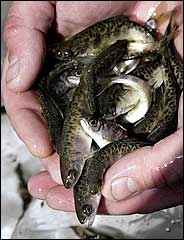forum
library
tutorial
contact

Salmon and Science
by EditorsNew York Times, October 9, 2004
|
the film forum library tutorial contact |

|
Salmon and Scienceby EditorsNew York Times, October 9, 2004 |
More than a dozen species of salmon in the Columbia and Snake River basins are at risk of extinction. One would think that these fish - culturally significant to Indian tribes and commercially valuable to a large regional fishing industry - could get a break. But they can't. A recovery plan devised by the Clinton administration was tossed out in 2003 by a federal judge who found its recommendations too speculative and ordered the Bush administration to draw up a better one. The Bush plan may be worse.
 True, the administration proposes technological fixes to help
fish over and around the Columbia and Snake River dams. Yet its
habitat protections are no stronger and, worse, it removes from
future consideration the idea of breaching the four dams on the
lower Snake River - an option the Clinton plan held in reserve
in case all other measures failed. Finally, in a bizarre
misreading of the Endangered Species Act, it abandons salmon
recovery as the goal of federal policy and asserts, in so many
words, that its only legal obligation is to keep the current
rate of decline from getting any worse.
True, the administration proposes technological fixes to help
fish over and around the Columbia and Snake River dams. Yet its
habitat protections are no stronger and, worse, it removes from
future consideration the idea of breaching the four dams on the
lower Snake River - an option the Clinton plan held in reserve
in case all other measures failed. Finally, in a bizarre
misreading of the Endangered Species Act, it abandons salmon
recovery as the goal of federal policy and asserts, in so many
words, that its only legal obligation is to keep the current
rate of decline from getting any worse.
Salmon seem especially disadvantaged by this administration's tendency to bend science and the law to its political agenda. Despite a huge fish kill in the lower Klamath River in Oregon in 2002, attributed by many scientists to federal irrigation policies that robbed fish of the water flows they needed, the Interior Department has yet to produce a plausible long-term plan to redistribute scarce water in a manner that satisfies all claimants.
And earlier this year, the administration proposed to count hatchery-raised salmon in its assessments of wild salmon populations. This mathematical commingling ignores crucial differences between wild and manufactured fish. But it would instantly make wild salmon populations look healthier than they are and give federal agencies a green light to lift protections against commercial activities in the watersheds where wild salmon spawn.
The decline of the once-abundant wild salmon runs of the Pacific Northwest ranks high on any list of environmental blunders. Despite recent healthy salmon runs, the result of unusually favorable weather and ocean conditions, the trend line for many wild salmon species is still downward. It will not be easy to turn this around. It will be harder still if the federal government ignores its obligations.
learn more on topics covered in the film
see the video
read the script
learn the songs
discussion forum
